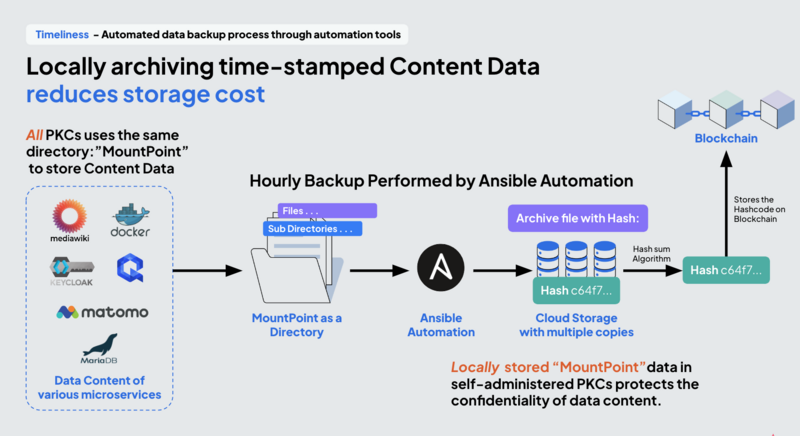SoG Processes and Resources
To ensure trustworthiness, the source code of PKC should not only be Open-sourced; it is even more important to be compliant to open and exchangeable formats. Open-source technology is usually created by other entities, so when mistakes in the software happen, the person would have a harder time identifying what exactly to fix. Open-format solves this issue as one can directly see the codes themselves. The following diagram shows the Open-source solutions adopted as the key functional elements of PKC.
A format is open if the encoding structure and the metadata regarding the structure is transparent and well-documented. One such technical effort to ensure openness is called Open API, originally the Swagger API project. It forces all computing services to produce results in JSON formats (human readable), offering a set of web-based graphical user interfaces to expose the metadata and allow data extraction and data submission to be operable through standard network requests. PKC adopts Open API protocol by exposing data content in the MediaWiki database. The other services such as Keycloak and QuantUX already have native implementations of Open API.
Connect Web3 into the Cloud Native Industry
Distributing these technology building blocks is not a new idea. It has been a massive social and economic movement in the making for at least 30+ years. The most relevant technologies include software container technologies such as Docker, container orchestration technologies such as Kubernetes, and OpenShift Framework for a standardized Continuous Integration and Continuous Delivery (CI/CD) tool chain. These software integration efforts are not only free, but they have abundant tutorials and community practitioners that can help create fully functional distributed data centers with near-zero software development cost. In terms of hardware infrastructure, PKC is designed to reduce the cost of data ownership by using commodity hardware solutions to enable remote and low-cost communication services, such as Wifi Mesh, and 3~5G access points. By localizing personal data storage, one may choose to only store the hash code of a large data set to Blockchain. This “layered” solution of data storage would retain a mechanism to verify data content that must be tamper-free, while not having to incur massive costs of data storage on public blockchain.
PKC can also locally serve computing services with containerized microservices, therefore reducing large amounts of unnecessary network traffic across the Internet and network operations costs. Docker containerization technology and virtualization enable us to see software package functionality as an instrument, rather than a bunch of code, thus enabling us to achieve our goals more concisely and consistently, allowing us to see the full scalability of the instrument.
It is the collection of all these existing Open-source technologies and commoditized hardware solutions that enabled the possible mass adoption of PKC. This container is a technology stack for trust-building that empowers individuals and agencies to exercise data sovereignty in affordable ways. For example, when one needs to share a file with many potential downloaders, a solution is to store it in the IPFS format and naming scheme, so that it can be addressed across the Internet based on its digital content. PKC can include an IPFS service node as one of its Dockerized services.
NFT: Transferring Governance Rights
Data formats also need to support exchangeability. A piece of data should be exchangeable in the marketplace by having a common set of annotation to denote its ownership and protect its content to only be editable by its owner. This can be accomplished by publishing/minting data assets as Non-Fungible Tokens (NFTs). Without going into the technical details of minting NFTs, the main obstacle of minting them is that public NFT minting services all require upfront cryptocurrency payments. The good news is that there are public minting and publishing services that require extremely low fees. NFTs, as a special kind of securely protected data content, allows for many kinds of workflow security programming that was not feasible before. For example, one may transfer the ownership of certain rights, which serves as the condition to modify or authorize information in a workflow, so that decision-making accountability can be programmatically controlled using an NFT ownership transfer. This is a critical feature in managing the governance of many organizations.
Content filtering independent of outside influence
An important feature of PKC is the ability to filter data content based on self-operated content filters. Controlling the filters is not only useful for preventing children from seeing age-inappropriate content, it can also be used to actively filter and prioritize content beneficial to social, intellectual, and economic activities. Running a privately owned knowledge container such as PKC will enable individuals to search, organize, and store data content in ways that can be isolated from data surveillance technologies. Without a self-administered knowledge container, online content consumption is inevitably influenced by external parties, which is not desirable: the ability to independently configure data filtering options with minimal external influence is an aspect of freedom to modern citizens. PKC serving the data filtering functions based on privately controlled computing services also enables a type of law enforcement possibility that does not intrude on individual privacy.
